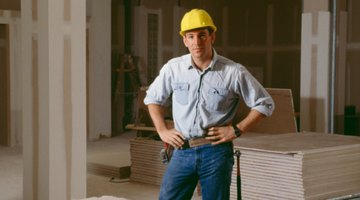Tips on Replacing a Damaged Mobile Home Ceiling With Drywall
Table of Contents
Mobile homes flex when being moved, which can often lead to roof leaks. Mobile home ceilings often get damaged from roof leaks and can be replaced with drywall. Drywall is a stronger, more durable wall and ceiling board, unlike ceiling tile used in many mobile homes.

Drywall ceilings give a clean look to the room and eliminate the plastic strips used on many mobile homes to support the ceiling tiles.
Removal
Before drywall is installed in a mobile home, the old ceiling must be removed. Removing any furniture in the room will give you a better work space and will prevent damage to the furnishings. Before the old ceiling can be taken out, all trim, light fixtures and ceiling fans attached to the ceiling must be removed. Store them in another room so that they can be reused, if desired. The ceiling can be removed with a hammer and flat bar. Be prepared for a lot of dust and debris; it may be helpful to wear a mask during demolition. Use pliers to pull out any remaining tile staples that don't come down with the ceiling tiles.
Preparation
After the old ceiling has been removed and the room has been cleared of debris, cover the floor with clean, vinyl-backed drop cloths to prevent drywall compound and drywall dust from damaging the floor. When drywall is being installed on a ceiling, some drips are to be expected. Open windows to let drywall dust escape if the weather permits. Cover the doors with plastic sheeting to prevent dust from entering other rooms in the home. Lay out all the drywall materials before beginning the installation; this ensures that everything is easily accessible and you have all the materials needed for the job.
Installation
Mobile homes are built to be lightweight, resulting in smaller framing materials than conventional houses. Drywall weighs considerably more than factory ceiling tiles; the most common size of drywall used is five-eighths of an inch thick. It may be best to use a thinner drywall, such as three-eights-inch drywall, in mobile homes for weight savings. The ceiling frame can be reinforced by installing 1-by-4-inch boards to use as furring strips. These furring strips are installed perpendicular to the ceiling joists and are spaced 12 inches apart, giving the drywall better support than the factory framing. Screw the drywall sheets onto the furring strips; use a drywall saw to cut out holes for light fixtures and vents.
Finishing Joints
After drywall sheets are screwed onto the furring strips, drywall mud must be applied to conceal the seams between each sheet. Skim a thin layer of drywall mud over one seam at a time. Stretch a piece of tape to cover the seam and smooth the tape with a drywall knife to remove air bubbles and wrinkles. Apply a generous layer of drywall mud over the taped seam, smooth it with a drywall knife and let it dry. Once the mud is dry, sand the seams to make a flat surface. Apply a fine skim layer of mud to fill in low spots and pock marks and sand with fine-grit sandpaper to finish. Repeat with each seam until the ceiling is finished.
Finish Coat and Texture
Drywall can be finished in several ways, such as smooth finish, painted, stippled and textured. Smooth finish and painting is a popular choice for many homeowners. Smooth finishing gives the ceiling a solid one-piece appearance and can be painted to match the room. Stippling is the process of stamping drywall compound to the ceiling with a stippling brush to create small bumps and ridges. This method gives the ceiling a heavy texture and can hide small blemishes in the drywall. Texture ceilings can be sprayed on with a texture sprayer or rolled on with a texture roller. Texture can have paint added to it to avoid painting on a final coat. The ceiling must be taped, coated and sanded before stippling and texturing; stippling and texturing will not hide a poor tape job.
The Drip Cap
- Mobile homes flex when being moved, which can often lead to roof leaks.
- Drywall ceilings give a clean look to the room and eliminate the plastic strips used on many mobile homes to support the ceiling tiles.
- Removing any furniture in the room will give you a better work space and will prevent damage to the furnishings.
- The ceiling can be removed with a hammer and flat bar.
- Use pliers to pull out any remaining tile staples that don't come down with the ceiling tiles.
- Open windows to let drywall dust escape if the weather permits.
- Apply a generous layer of drywall mud over the taped seam, smooth it with a drywall knife and let it dry.
References
Writer Bio
A former cake decorator and competitive horticulturist, Amelia Allonsy is most at home in the kitchen or with her hands in the dirt. She received her Bachelor's degree from West Virginia University. Her work has been published in the San Francisco Chronicle and on other websites.
Photo Credits
- Jupiterimages/Photos.com/Getty Images
- Jupiterimages/Photos.com/Getty Images
More Articles
- How to Install Drywall over a Popcorn Textured Ceiling
- How to Remove Old Ceiling Tiles
- Should I Tape & Plaster Drywall if I'm Putting Tile on?
- How to Replace Paneling With Sheetrock and the Cost of Replacement
- Why Are Joists Visible Through a Smooth Ceiling?
- What Is the Minimum Distance From the Rafters to a Drop Ceiling?



